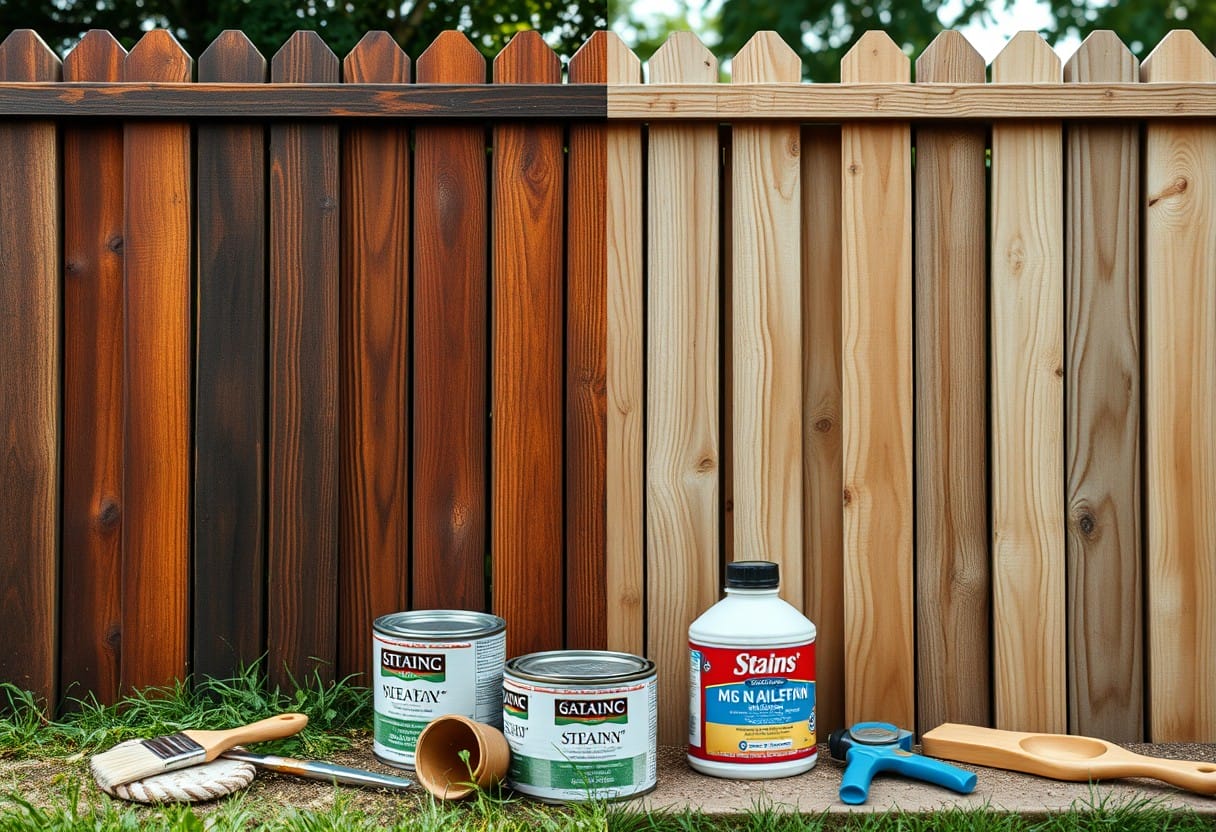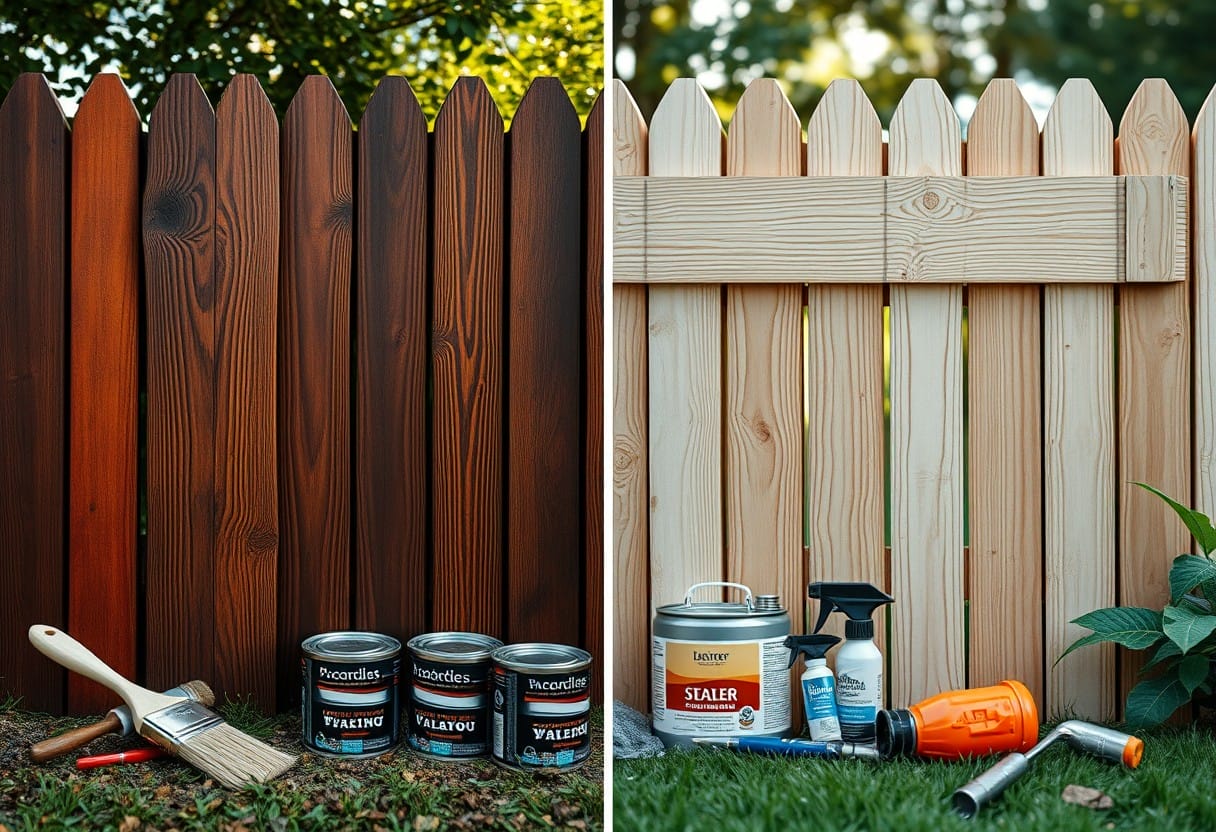Fence maintenance is crucial for extending the lifespan and enhancing the appearance of your outdoor structure in various areas of Roanoke, VA. When deciding between staining and sealing, it’s imperative to understand the benefits each option provides. Staining can add color and protect your fence from UV rays, while sealing primarily offers moisture resistance. In this post, you will explore the advantages and disadvantages of both methods, helping you make an informed choice for your fencing needs.

Key Takeaways:
- Protection: Sealing a fence provides a protective barrier against moisture and UV damage, whereas staining adds color while offering some protection.
- Aesthetics: Staining enhances the natural beauty of the wood, allowing for various shades, while sealing typically maintains the original appearance of the wood.
- Maintenance: Stained fences may require more frequent upkeep due to fading, while sealed fences often have a longer-lasting protective barrier.

Understanding Staining
To make an informed choice between staining or sealing your fence, it’s crucial to understand the nuances of staining.
What is Staining?
Staining is the process of applying a colored or clear solution to your wooden fence that penetrates the wood fibers. This treatment enhances the natural grain while providing protection against moisture, UV rays, and fungal growth.
Types of Stains
Stains come in various formulations designed to enhance the appearance and longevity of your fence. Here’s a breakdown of the main types:
| Type | Description |
| Transparent Stains | Showcase the natural beauty of wood while offering minimal protection. |
| Translucent Stains | Provide a slight color while still allowing the wood grain to be visible. |
| Solid Stains | Thicker and offer the most coverage, resembling paint. |
| Oil-based Stains | Penetrate deeper into the wood for long-lasting results. |
| Water-based Stains | Dry quickly and have lower VOCs but may require more frequent reapplication. |
- Choosing the right stain depends on your desired aesthetic and the level of protection you seek.
On top of the types mentioned, each stain offers unique characteristics suited to various environments. You might favor oil-based stains for their deep penetration, particularly in areas with high moisture. Conversely, if quick drying times and low environmental impact are priorities, a water-based stain could be ideal.
| Feature | Benefit |
| Ease of Application | Water-based stains are often easier and faster to apply. |
| Durability | Oil-based stains tend to last longer before needing reapplication. |
| Color Variety | Solid stains offer extensive color choices. |
| Environmental Impact | Water-based options have lower VOCs, making them more eco-friendly. |
| Maintenance | Check the type of stain used to plan your maintenance schedule. |
- Thou should consider how each type impacts your maintenance routine and overall design preferences.
Benefits of Staining
Any type of fencing can benefit from staining as it adds an extra layer of protection while improving aesthetic appeal. This treatment helps prevent water damage, minimizes warping, and combats mold growth.
A significant advantage of staining is that it allows you to maintain the natural look of the wood. Unlike paint, which can peel and crack, stains penetrate the wood and enhance its texture, offering a more long-lasting finish. Additionally, the protective qualities of stains shield your fence from the harmful effects of sun exposure and moisture.
Understanding Sealing
Some homeowners are often faced with the decision of whether to stain or seal their fences. Understanding sealing can be crucial for maintaining the longevity and appearance of your fence. For more insights, check out this discussion on New fence – spray or brush on stain sealant? – LumberJocks.
What is Sealing?
To seal a fence involves applying a protective barrier that prevents moisture, UV rays, and other environmental factors from damaging the wood. This process is crucial to prolonging the life of your fence and preserving its natural look.
Types of Sealants
What you choose for sealing your fence can significantly impact its performance. Various sealants are available on the market, each tailored to have specific properties and advantages:
| 1. Clear Sealants | Transparent finish preserving natural wood color. |
| 2. Tinted Sealants | Adds color while still allowing wood grain to show. |
| 3. Water-Based Sealants | Quick drying and environmentally friendly. |
| 4. Oil-Based Sealants | Provides longer-lasting protection but takes longer to dry. |
| 5. Hybrid Sealants | Combines benefits of both oil and water-based options. |
Any sealant you select should be compatible with your fence material and climate conditions for best results.
Benefits of Sealing
An effective sealing process can provide multiple advantages for your fence. It helps prevent damage that might otherwise lead to costly repairs or replacements.
Benefits of sealing include enhanced protection against moisture and UV rays, which can cause wood to warp, crack, or fade. Furthermore, sealing your fence can minimize the risk of mold and mildew growth, ensuring that your structure remains aesthetically pleasing and structurally sound.

Comparing Staining and Sealing
Not every fence requires the same treatment, and knowing whether to stain or seal can significantly impact your fence’s lifespan and appearance. Explore the different benefits and drawbacks of both options to help you make an informed decision. When contemplating your choices, consider checking out When Can I Stain or Seal My New Wood Fence? for helpful guidelines.
| Criteria | Staining |
| Longevity and Durability | Typically lasts 3-5 years; offers better UV protection |
| Aesthetic Considerations | Enhances wood grain; various color options available |
| Maintenance Requirements | Requires more frequent reapplication |
| Environmental Impact | Some stains use eco-friendly components; check labels |
Longevity and Durability
The durability of your fence can depend significantly on whether you choose to stain or seal it. Staining usually provides better long-term protection against UV rays and moisture, lasting about 3-5 years, while sealing may need less frequent applications but often doesn’t protect against fading as effectively.
Aesthetic Considerations
An important aspect of your fence’s appearance is how it looks in your yard. Stains come in various colors and can enhance the natural grain of the wood, giving it a richer look, whereas sealers generally maintain the wood’s original color and only provide a glossy or matte finish.
Understanding that the choice of stain can transform the entire visual appeal of your outdoor space is crucial. Opting for a stain can accentuate natural textures and create a more inviting ambiance, while a clear seal allows the wood’s original beauty to shine through without altering its appearance.
Maintenance Requirements
For those who prefer lower upkeep, sealing may be a better option, as it generally lasts longer between applications. However, if you choose to stain your fence, be prepared for more frequent maintenance to keep it looking fresh.
To minimize your long-term workload, consider the weather conditions in your area. In environments that are prone to high moisture or UV exposure, staining might require reapplication sooner, whereas sealing can provide a more extended interval between touch-ups.
Environmental Impact
Aesthetic choices can also have environmental implications, especially when selecting stains or seals. Some products contain harmful chemicals, so you need to investigate thoroughly to find options that are better for the environment.
Environmental sustainability is becoming a key consideration for many homeowners. By choosing eco-friendly stains or sealers, you not only enhance the aesthetic of your fence but also contribute positively to the health of your surrounding ecosystem. Always look for products that are low in volatile organic compounds (VOCs) to lessen your environmental footprint.
Summing up
Now that you understand the pros and cons of staining versus sealing your fence, the decision ultimately depends on your specific needs and aesthetic preferences. Staining offers a variety of colors and enhances wood grain, while sealing provides clear, long-lasting protection. Consider factors such as climate, maintenance, and desired appearance when making your choice. By addressing these elements carefully, you can ensure your fence remains beautiful and well-protected for years to come.
FAQ
Q: Is it better to stain or seal a fence?
A: The choice between staining and sealing a fence often depends on the specific conditions you are facing, such as the wood type, the local climate, and your desired aesthetic. Stains typically provide color, enhance the wood grain, and offer some protection, while sealers are usually clear and more focused on waterproofing the wood. For more details, call Pro Fence Company , Roanoke Virginia now.
Q: What are the main benefits of staining a fence?
A: Staining a fence can significantly enhance its appearance by adding color and depth. It also helps protect the wood from UV damage, moisture, and mildew. Additionally, stains penetrate the wood, providing lasting color while allowing the wood to breathe, which can be beneficial in avoiding rot.
Q: What are the benefits of sealing a fence?
A: Sealing a fence primarily provides a protective barrier against water damage and rotting. It helps prevent moisture from seeping in, thus reducing the risk of mold and mildew. Sealers can also create a clear finish that highlights the natural beauty of the wood without altering its color.
Q: How long does a stain last compared to a sealer?
A: Stains typically last between 2 to 5 years, depending on the type, brand, and weather conditions. In contrast, sealers may last about 1 to 3 years. It’s crucial to regularly maintain both applications to ensure the best protection for your fence.
Q: Can I apply stain and sealer together on my fence?
A: It is generally not recommended to apply stain and sealer together as they serve different purposes. If you choose to stain, applying a sealer afterwards may prevent the stain from adhering properly and may lead to peeling. It is best to stick with one method or thoroughly consult with a professional.
Q: What is the best time of year to stain or seal my fence?
A: The best time to stain or seal a fence is during dry weather when temperatures are moderate, generally in spring or fall. Avoid applying either treatment on extremely hot days or when rain is expected within 24 hours, as these conditions can affect adherence and drying time.
Q: How do I prepare my fence for staining or sealing?
A: Preparing your fence involves cleaning and possibly sanding it to remove any old finishes, dirt, or mildew. Make sure the fence is dry before application, as moisture can affect the adherence of both stains and sealers. For staining, ensure you choose the right stain that suits your wood type and desired finish.


Leave a Reply